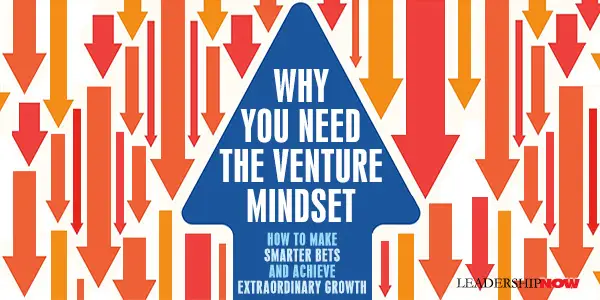
Why You Need the Venture Mindset

WITH uncertainty as a given, we need to approach what we do with a different mindset. Innovation is key to sustainability. The Venture Mindset offers a way to rethink your decision-making process.
Ilya Strebulaev conducted the largest survey of VC investors, held hundreds of interviews, and collected what became the largest database of unicorns and unicorns-to-be and their founders. This search revealed many practices of VCs. Together with a venture builder Alex Dang they translated these learnings into practical lessons for traditional organizations and present them in The Venture Mindset.
So, what is the Venture Mindset?
The Venture Mindset is a new mental model where failure is a must, due diligence is put on its head, dissent is encouraged, ideas are rejected in their myriads in search of a single winner, plugs are pulled, and time horizons are extended.
Here are the nine key aspects of the Venture Mindset, the most important guiding principles:
Home Runs Matter, Strikeouts Don’t
VCs worry more about errors of omission than they do about errors of commission. Most organizations get that turned around. The concern is not the chance of failure but the risk of missing out on the possible success.
“The goal is not to win each time. The goal is not to miss the opportunity to win big at least once.” That means that you have to experiment and be comfortable with accepting failure. Every decision made will not be a win. To win in the end, “you need to be making bolder, riskier plays than you think” without betting the farm. Have more than one bet.
It is important, too, to weed out your portfolio of ideas and focus on the most promising. “Too many ideas may distract and disorient the management.”
Get Outside the Four Walls
Work giving consideration for what is happening outside your organization. “Corporate decision makers have lots of people and resources at their disposal within their four walls. As a result, project ideas arise from what is available within the organization.” Source ideas and deals from outside and from unusual places. Go wide.
This inability to source deals from outside the four walls, and to do so quickly, is one of the main reasons why innovation in so many companies is stifled. The pipeline of ideas inside your four walls is simply not big enough. The challenge is often not a lack of resources or smart people, but of a critical mass of ideas or too great a similarity between those ideas. Too often, organizations select initiatives from a small number of internally available options.
In an uncertain environment, you need to be more curious.
Prepare Your Mind
When deciding to invest or move forward, VCs take a red-flag approach. They ask, “Why don’t I want to invest?” “VCs reduce the seemingly inordinate complexity of deal selection by searching for a decisive reason to reject an opportunity rather than advancing it to the next stage of consideration.” What is the way out of this idea?
The reasons to go or no-go become obvious when you have prepared your mind to see them. “VCs rely on their pattern recognition skills, developed through numerous meetings with entrepreneurs and hundreds of hours spent flipping through pitch decks and industry studies and connecting the dots in the vague universe of startup facts and outcomes. It may seem, even to them, like a gut decision, but it has been foreshadowed by a long period of tireless effort.”
Pattern recognition happens when you back off and take the 10,000-foot view.
Say No 100 Times
Say no more but thoughtfully. Consider many ideas, but funnel each idea through a funnel or criteria. Most will not make the first stage or cut. Those that do keep working them down through the funnel to identify the best idea. The authors advise: “To avoid lemons, evaluate more cars! Expand your idea and become disciplined about how you go through it, using different criteria at each stage.”
Bet on the Jockey
The team is key. The human element matters. VCs distinguish between “startup failures” and “founder failures.” VCs “are unhesitant to keep betting on the founders if they determine that the was not because of the founders.”
Execution matters. “VCs know that ideas are a dime a dozen; execution of the idea makes all the difference.” Venture capitalist Georges Doriot advised, “Always consider investing in a grade A man with a grade B idea. Never invest in a grade B man with a grade A idea.”
When designing an intrapreneurship culture, keep in mind: “Internal startups are run by highly motivated lean teams, without clear supervision from above, yet with tacit support and broad orientation of direction.”
Too many traditional organizations hope that a single person from a large tech company can make the difference. A single person cannot. You need a team. By bringing multiple people with a new mindset in, you can kickstart innovation. Innovation is a team sport indeed.
Agree to Disagree
Be wary of consensus. When uncertainty is high, and there are many unknowns, consensus is a danger and often biased. “People compromise, converge, and seek consensus.”
For stability, go for consensus; for breakthroughs, rely on the VC mindset way, VCs are not consensus seekers. They love arguing, fighting for their view of the future, listening carefully to others across the table, and kicking ideas around. The majority often rules, but that doesn’t mean the majority is right.
Seek disagreement. Replace the need to be right with the satisfaction of discovering the truth. Get junior team members to talk first before seniors can tilt the discussion in a specific direction. Assign a devil’s advocate. You need those in the group who are “ready to dissent, disobey, stick to their views, or rebel against the others.” (This describes many entrepreneurs.) Remember, “silence in the room does not mean consent; rather, it is a strong sign of potential disaster.”
Double Down or Quit
Keep your options open. “To win in the long run, you must be flexible and ready to change your mind every time you collect more information.”
We get attached to our decisions. “Our human nature resists reversing course and cutting our losses, even in life-or-death situations—and especially if we think we are so close to being on top of the world. Inexperienced players don’t fold frequently enough. We simply want to be right—even though we already suspect that we were wrong.”
Always avail yourself of an unbiased perspective.
Make the Pie Bigger
VCs know that everyone who shares the pain must share in the gain. “The Venture Mindset solves the principal-agent problem by making everyone a shareholder. Instead of looking for ways to get a larger piece of the pie, everyone is busy growing the pie.
Imagine that you are the founder of a very successful startup. How much would you own when your company hits an all-important IPO milestone? When we disclose the average percentage, many are surprised. Only 15 to 20 percent of the shares are typically left for all the cofounders. The founders of Lyft, Box, and Pandora kept only 6 percent, 4 percent, and 2 percent, respectively. Why would people accept such arrangements? Because VCs and founders of VC-backed companies prefer a smaller slice of a larger pie rather than the other way around.
Great Things Take Time
Think long-term. The changes coming will not happen in a single budget cycle. These are long-term trends and must be considered with long-term thinking and planning.
Patience and long-term thinking free the mind from unnecessary limitations and push us to think about what might happen to the world in five, ten, or fifteen years. They force us to look beyond day-to-day routines.
Extend your horizon and focus on the journey and not the final destination.
Adopting a Venture Mindset begins with people and their mindset. Experiment with small bets. Start with a current issue and consider ways to break the status quo. What might be done?

![]()
Posted by Michael McKinney at 05:53 PM
Permalink
| Comments (0)
| This post is about Creativity & Innovation
, Entrepreneurship
Discover more from reviewer4you.com
Subscribe to get the latest posts to your email.







